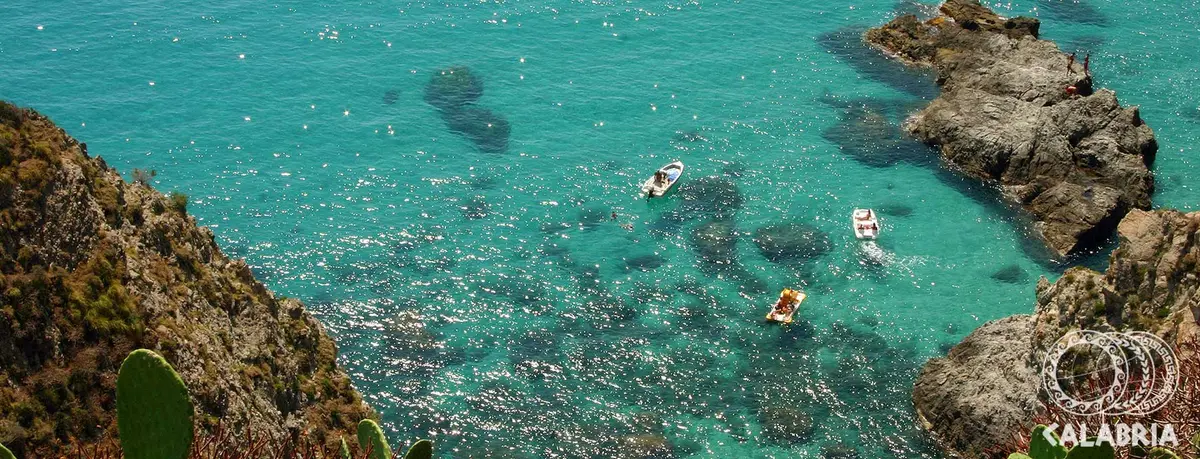From dream beaches to the home of the Mediterranean Diet

Landscape
Travel information
Category
Landscape
Target
Among the many scenic wonders of Calabria, the Costa degli Dei is perhaps one of the most famous stretches. The name is used to indicate those 55 km of southern Tyrrhenian coastline from Pizzo Calabro to Nicotera, morphologically very varied, which delimit the so-called Horn of Calabria. The name, in this case, is really a guarantee: the Coast is called the Coast of the Gods precisely because it evokes dreamlike imagery. In fact, there are white beaches, crystal clear sea and seabed full of wonderful living forms capable of making the happiness of every diver.
Following the coast road from north to south you will find places that deserve more than a visit, such as Pizzo Calabro, Tropea, Capo Vaticano and Nicotera. Without forgetting to make a detour in the beautiful Regional Natural Park of Serre.
Itinerary suitable for everyone, practicable by car, recommended in spring, summer and autumn.
Food tips
Aphrodisiac, antiseptic, anesthetic, diuretic, cures rheumatism, avoids colds and flu and much more: the Red Onion of Tropea Calabria PGI is one of the most famous products of the region, the basis of many typical recipes and home remedies. You can find it in three shapes: round with a sweet taste, conical with a sweet and sour taste, oval with a strong taste. In the local cuisine (but not only) it is now found in so many recipes that it has become almost more indispensable than parsley: from soups to omelettes, from jams to salads, where it can be enjoyed raw in all its crunchiness.
One of the products which best expresses all the spicy soul of Calabria is the 'Nduja of Spilinga. It is a soft and spreadable sausage and, above all, very spicy. Loved by those who prefer strong flavors, historically 'nduja was produced with what remained of the processing of other Calabrian salami. It is then flavored with Calabrian chilli pepper, naturally dried, which gives it its typical fiery red color and unmistakable aroma. It is simply excellent to be tasted naturally spread on bread or pizza, as an appetizer or to make croutons or bruschetta, but also to be put in the sauce to season every kind of pasta.
The Tartufo di Pizzo IGP is the first ice cream in Europe to have obtained the IGP mark thanks to the quality of its artisan production. On the market there are many industrial versions of this sweet, but nothing has to do with the original one: to taste the real Pizzo IGP Truffle you must necessarily go to Pizzo Calabro, where this sweet delicacy was created in 1952, in the Gran Bar Excelsior. In that year, in fact, ice cream maker Giuseppe De Maria, in occasion of an important wedding, ran out of molds and shapes to make ice cream for his numerous guests. So he put a portion of hazelnut ice cream in the hollow of his hand over a layer of chocolate ice cream, he put some melted chocolate inside and wrapped everything in a sheet of sugar paper giving it the typical shape of a truffle. This improvised creation was a real success, which gave immediate fame to the place and to the whole town of Pizzo Calabro. The artisan method has not changed and the truffle is still made in the same way today. But what makes it unique and inimitable is the quality of the ingredients and the use of machinery that is still very old.
In the territory of Monte Poro is produced one of the best sheep cheeses of the South, the Pecorino di Monte Poro. This particular cheese is obtained from the processing of sheep's milk obtained from sheep fed in natural pastures on the slopes of the plateau, sheep Comisana, Sardinian and in some cases of malvizza. Before placing the cheese in the maturing process, the rind is treated with olive oil and chili pepper, which gives the surface a characteristic orange color. Pecorino di Monte Poro can be eaten as early as three months of aging, but it is after medium aging (five to six months) or one year that it releases the best of its flavor.

Pizzo Calabro

Tropea

Capo Vaticano

Nicotera




